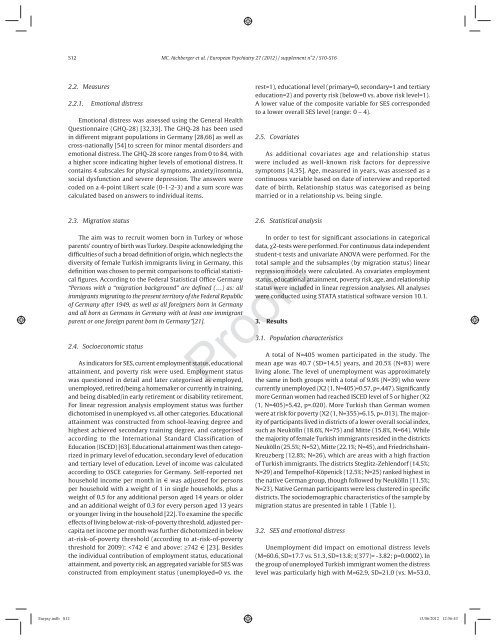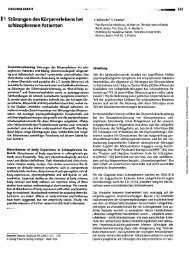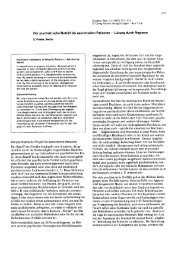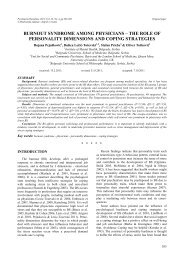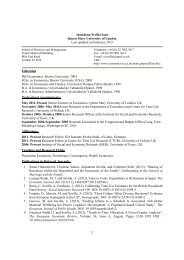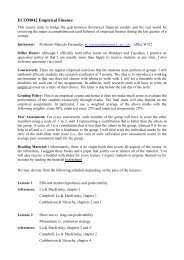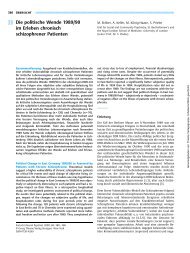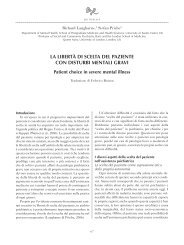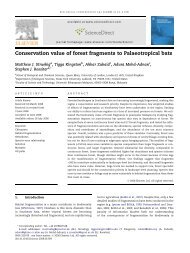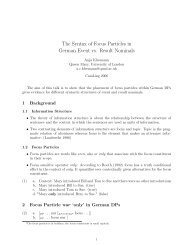Proofs - Personal Webspace for QMUL - Queen Mary, University of ...
Proofs - Personal Webspace for QMUL - Queen Mary, University of ...
Proofs - Personal Webspace for QMUL - Queen Mary, University of ...
You also want an ePaper? Increase the reach of your titles
YUMPU automatically turns print PDFs into web optimized ePapers that Google loves.
S12 MC. Aichberger et al. / European Psychiatry 27 (2012) / supplement n°2 / S10-S16<br />
2.2. Measures<br />
2.2.1. Emotional distress<br />
Emotional distress was assessed using the General Health<br />
Questionnaire (GHQ- 28) [32,33]. The GHQ- 28 has been used<br />
in different migrant populations in Germany [28,66] as well as<br />
cross- nationally [54] to screen <strong>for</strong> minor mental disorders and<br />
emotional distress. The GHQ- 28 score ranges from 0 to 84, with<br />
a higher score indicating higher levels <strong>of</strong> emotional distress. It<br />
contains 4 subscales <strong>for</strong> physical symptoms, anxiety/insomnia,<br />
social dysfunction and severe depression. The answers were<br />
coded on a 4- point Likert scale (0- 1- 2- 3) and a sum score was<br />
calculated based on answers to individual items.<br />
2.3. Migration status<br />
The aim was to recruit women born in Turkey or whose<br />
parents’ country <strong>of</strong> birth was Turkey. Despite acknowledging the<br />
diffi culties <strong>of</strong> such a broad defi nition <strong>of</strong> origin, which neglects the<br />
diversity <strong>of</strong> female Turkish immigrants living in Germany, this<br />
defi nition was chosen to permit comparisons to <strong>of</strong>fi cial statistical<br />
fi gures. According to the Federal Statistical Offi ce Germany<br />
“Persons with a “migration background” are defi ned (…) as: all<br />
immigrants migrating to the present territory <strong>of</strong> the Federal Republic<br />
<strong>of</strong> Germany after 1949, as well as all <strong>for</strong>eigners born in Germany<br />
and all born as Germans in Germany with at least one immigrant<br />
parent or one <strong>for</strong>eign parent born in Germany”[21].<br />
2.4. Socioeconomic status<br />
As indicators <strong>for</strong> SES, current employment status, educational<br />
attainment, and poverty risk were used. Employment status<br />
was questioned in detail and later categorised as employed,<br />
unemployed, retired/being a homemaker or currently in training,<br />
and being disabled/in early retirement or disability retirement.<br />
For linear regression analysis employment status was further<br />
dichotomised in unemployed vs. all other categories. Educational<br />
attainment was constructed from school- leaving degree and<br />
highest achieved secondary training degree, and categorised<br />
according to the International Standard Classification <strong>of</strong><br />
Education (ISCED) [63]. Educational attainment was then categorized<br />
in primary level <strong>of</strong> education, secondary level <strong>of</strong> education<br />
and tertiary level <strong>of</strong> education. Level <strong>of</strong> income was calculated<br />
according to OSCE categories <strong>for</strong> Germany. Self- reported net<br />
household income per month in € was adjusted <strong>for</strong> persons<br />
per household with a weight <strong>of</strong> 1 in single households, plus a<br />
weight <strong>of</strong> 0.5 <strong>for</strong> any additional person aged 14 years or older<br />
and an additional weight <strong>of</strong> 0.3 <strong>for</strong> every person aged 13 years<br />
or younger living in the household [22]. To examine the specifi c<br />
effects <strong>of</strong> living below at- risk- <strong>of</strong>- poverty threshold, adjusted percapita<br />
net income per month was further dichotomized in below<br />
at- risk- <strong>of</strong>- poverty threshold (according to at- risk- <strong>of</strong>- poverty<br />
threshold <strong>for</strong> 2009):


